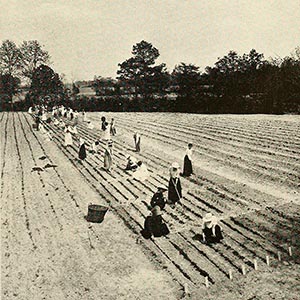
In 1915, international discussions of possible food shortages began to impact ECTTS. While few worried that the United States would experience one, the fear was that global demand might not be met by American agriculture, especially if there were war. As a result, Americans were encouraged to produce as much food as possible so as to maximize agricultural supplies. By 1917, President Woodrow Wilson had issued statements emphasizing that the U.S. might have to feed both itself and “a large proportion of the people of Europe” for years to come. He even claimed that “upon the farmers of this country, therefore, in large measure, rests the fate of the war and the fate of the nations.”
ECTTS addressed this challenge by incorporating a gardening curriculum in with domestic science studies. One student, Christine Johnston, writing in 1915, confessed surprise at finding herself and others “with hoes, garden rakes, and three-prong cultivator hoes on their way to make their school gardens.” Assigned joint responsibility for an 8 X 15 foot plot, Johnston and her partner learned the principles of agriculture “by actual work” rather than “by just reading about them.” Johnston chronicled her gardening experience during the spring term of her senior year, concluding without regret that she “had been brought into intelligent sympathy with one of the great occupations of man.” The 1915 Training School Quarterly included two pictures entitled, The Students’ Gardens at East Carolina Teachers’ Training School,” showing long rows of plowed land divided in the 8 X 15 plots, with two girls per plot out tending their gardens.
The Training School Quarterly also published articles, notes, and editorials about gardening, canning, and the need for more student, and indeed female, involvement in food production. Lesson plans were published showing how teachers might incorporate gardening into their schools. Some even claimed that women had superior abilities in gardening, and at the very least, were often the ones in charge of home gardens even in rural areas. Men more typically concerned themselves with cash crops such as tobacco and cotton. One editorial added that the State of North Carolina required “the teaching of agriculture in the rural schools.” Since most rural teachers were women, it was imperative, the editorial added, that they “know something of the basic principles,” adding that if a teacher encouraged people to “take interest in their gardens,” she would have done much to help them. Over and again, Training School Quarterly essays affirmed that women could teach agriculture, and that such should be taught them at the Training School. The student gardens were teaching tools at the Training School.
Sources
- Armstrong, Martha. “School Luncheons in Rural Schools,” “Four-year Garden Course for Girls.” Training School Quarterly. Vol. 2, no. 4. January, February, March, 1916. Raleigh: Edwards & Broughton, 1916. Pp. 253-256.
- Austin, Herbert. “Approaching Agriculture through the Small Garden.” Training School Quarterly. Vol. 2, no. 1. April, May, June, 1915. Raleigh: Edwards & Broughton, 1915. Pp. 15-16.
- Busbee, Jaques. “My Blue and Gold Garden.” Training School Quarterly. Vol. 2, no. 1. April, May, June, 1915. Raleigh: Edwards & Broughton, 1915. Pp. 17-18.
- Busbee, Jaques. “Plans for Planting the Campus.” Training School Quarterly. Vol. 2, no. 1. April, May, June, 1915. Raleigh: Edwards & Broughton, 1915. Pp. 35-38.
- “Class of 1915: Senior Gardens.” Training School Quarterly. Vol. 2, no. 1. April, May, June, 1915. Raleigh: Edwards & Broughton, 1915. P. 66.
- Houston, David. “Food and Feed First.” Training School Quarterly. Vol. 4, no. 1. April, May, June, 1917. Raleigh: Edwards & Broughton, 1917. P. 11.
- Johnston, Christine. “My Garden.” Training School Quarterly. Vol. 2, no. 2. July, August, September, 1915. Raleigh: Edwards & Broughton, 1915. Pp. 125-126.
- Monahan, A. C. “Extension Teaching in Agriculture and Household Arts in Ireland.” Training School Quarterly. Vol. 2, no. 1. April, May, June, 1915. Raleigh: Edwards & Broughton, 1915. Pp. 1-6.
- Poe, Clarence. “Educating for Farm Life.” Training School Quarterly. Vol. 2, no. 1. April, May, June, 1915. Raleigh: Edwards & Broughton, 1915 Pp. 8-12.
- “Practical Agriculture at the Training School Gardens.” Training School Quarterly. Vol. 4, no. 1. April, May, June, 1917. Raleigh: Edwards & Broughton, 1917. P. 51.
Citation Information
Title: School Gardens
Author: John A. Tucker, PhD
Date of Publication: 6/11/2018